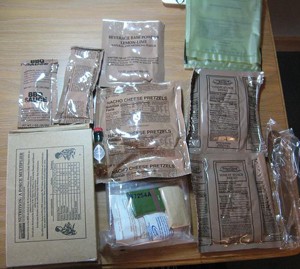Of course with ‘lock down’ conditions we were unable to dine at the Dundas Buffett. We were shifted from meals of bacon or sausage for breakfast, cold cuts or a hot dish for lunch, and a pork loin, chop, or rib selection for dinner to the storm rations (Meals-Ready-to-Eat: MREs). These ‘meals in a bag’ aren’t as bad as they look. My meat patty and macaroni and cheese were tasty, but I won’t be stocking up on them any time soon.
Finally the weather cleared and after a two day break focused on base clean up we got the all clear to fly again. Due to the short time remaining to collect data in this part of the mission the long awaited flight to Fairbanks was shortened.Instead of an overnight stay in Alaska the decision was made to fly as far as the fuel and time would allow. Although visibility floated in and out and ice formed along the outside of the plane, about two thirds of the data was collected by the time we reached the flight turn around point at MacKenzie Delta, Canada. We considered the flight a success, and I think the whole mission team was glad to to say this one was completed.


